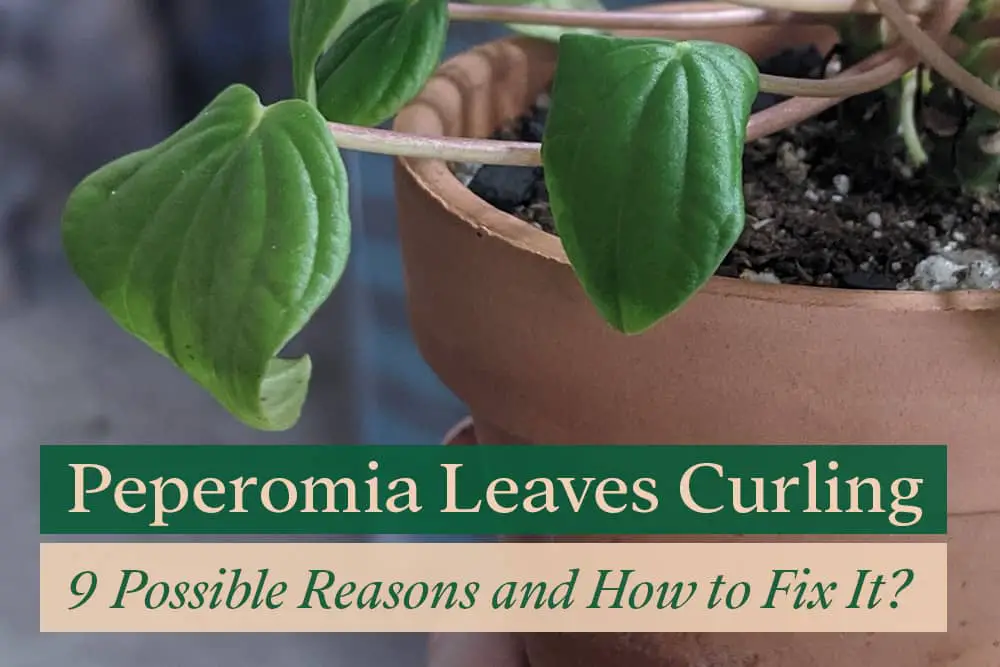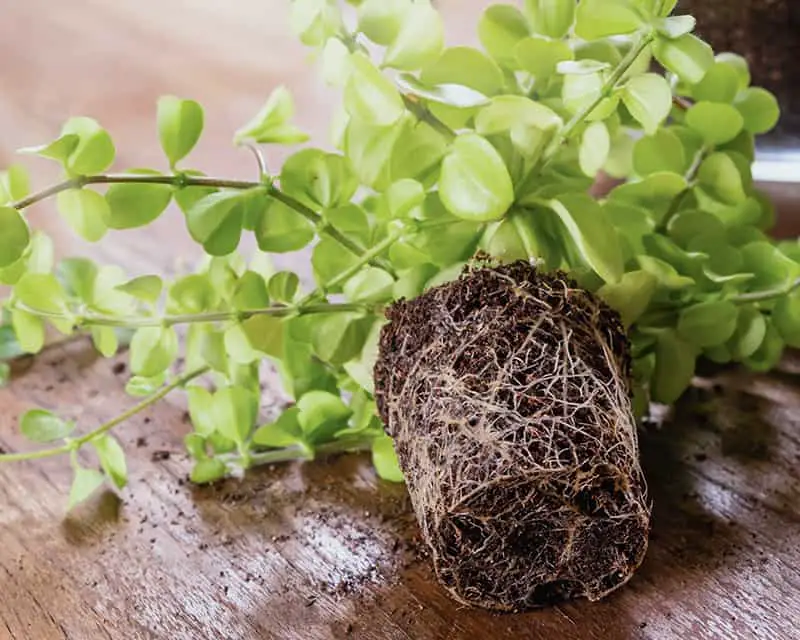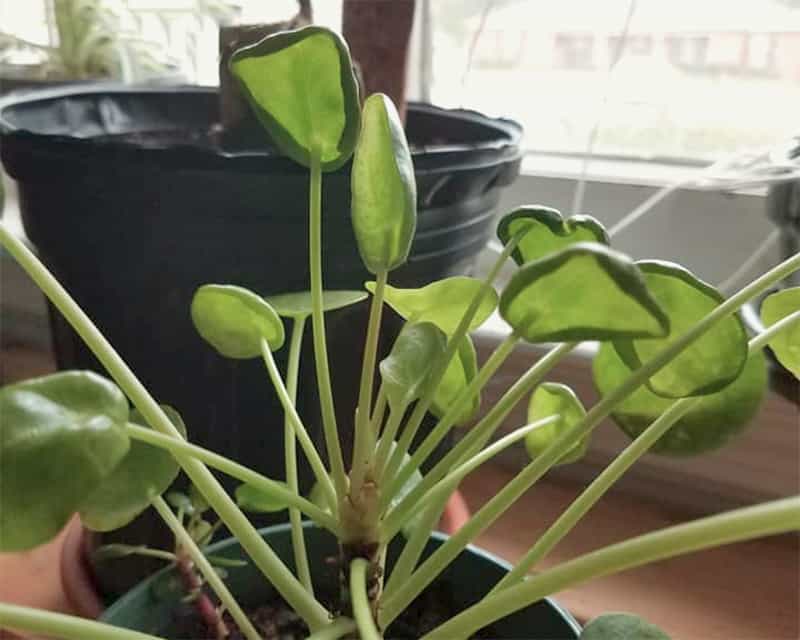
“Help! Why are my Peperomia leaves curling?”.
Despite doing your best to take care of the plant, you will still experience curling leaves in Peperomia.
When dehydrated, Peperomia leaves curl to reduce transpiration and prevent further water loss. However, excess watering, low humidity, high temperatures, over-fertilization and root rot can also cause leaves to curl.
In this article, I’ll show you how to accurately identify what’s causing your Peperomia leaves to curl and how to efficiently fix them.
Now, let’s get started!
Underwatering
The thick succulent-like leaves and stems of peperomia effectively retain water. So they don’t require as much watering as other popular houseplants like Monstera and Calathea.
I water them every two weeks, and it seems to be working well for my Peperomia Argyreia (Watermelon Peperomia) and Peperomia Hope.
However, if the plant goes without water for too long, the leaves will start to curl inward to reduce the surface area through which moisture escapes.
Identifying underwatered Peperomia
In addition to curling leaves, indicators of a dehydrated Peperomia plant include dry soil, sagging stems, and yellowing, crispy leaves. Any of these signs may indicate that your Peperomia needs watering.
Here’s how you can test if your soil is dry:
Stick your finger 2 inches into the topsoil to test for moisture. If your finger comes out clean, your soil is dry.
As an alternative, you can also use a soil meter to get an accurate reading on the moisture level of your soil.
How to fix underwatered Peperomia:
The good news is that rehydrating underwatered Peperomia plant is easy.
Simply soak the plant in a container filled with room temperature water for 30 minutes, or until the soil expands and appears moist.
After that, remove the pot from the container and allow the excess water to drain through the drainage holes for another 30 minutes.
Your Peperomia plants should recover in 24 hours if everything is done correctly.
If the process fails, it’s possible your soil is hydrophobic, in which case water drains quickly without wetting it.
Overwatering
In a similar way, overwatering can cause peperomia leaves to curl.
There are several causes of overwatering, such as too frequent watering or using heavy and poorly draining soil. This will cause the roots to remain wet for too long in waterlogged soil and develop root rot.
Rotting roots prevent plants from absorbing water and nutrients from the soil properly. Thus, overwatered Peperomia displays similar signs to droughts and mineral deficiencies.
Identifying Overwatered Peperomia
In the early stages of overwatering, the leaves curl upward and develop brown tips. These leaves may also feel soft, limp, and start turning yellow.
If you test your soil, you will discover that the soil does not dry out even after two weeks. If you do nothing, you may start to notice a foul odor emanating from your soil.
Lastly, inspect the roots of your plant once it has been removed from its pot, you will notice they have turned black and are mushy.
How to fix waterlogged Peperomia
Stop watering your Peperomia if you believe it is overwatered. Only water when the top 2 inches of soil are dry.
Consider improving drainage and creating air spaces around the roots. Use a chopstick to probe the soil several times. Don’t worry if you snap a few roots.
For black and mushy roots, cut them out and treat them with 3% hydrogen peroxide to kill pathogens before repotting them into better aerated and well-draining soil.
Low Humidity
Although Peperomia is pretty forgiving of low humidity conditions, they do prefer humid air that is at least above 50%.
When the humidity falls below 40%, your peperomia will begin to lose moisture more rapidly through transpiration, forcing the roots to absorb water to make up for the loss.
In response to low humidity, the plant curls its leaves to reduce the surface area from which water vapor escapes.
Identifying Peperomia suffering from low humidity
Frequently, signs of low humidity in plants can be mistaken for signs of under-watering.
When the Peperomia root cannot replace the water loss quickly enough, the cells lose their turgidity and wilt.
During this period, your plant’s stems will begin drooping and the leaves’ tips will turn brown and dry.
To accurately rule out under-watering as the cause of the curling, you will need to purchase a hygrometer and evaluate the humidity levels in your room.
How to save Peperomia from low humidity
You can improve your room humidity by adding more water vapor to the air.
Misting, using pebble trays, and leaving the bathroom door open while showering can all help, but the humidity boost usually dissipates after a few minutes.
The most efficient way to improve low humidity is to use plant humidifiers that can detect and turn on/off automatically when the humidity is too low/high. This allows the humidifier to keep the air humid without oversaturating it.
Heat Stress
Peperomia prefer to grow at room temperature between 60°F to 80°F (15⁰C – 27⁰C) and away from direct sunlight.
When temperatures rise over 90°F (32⁰C), soil moisture evaporates rapidly, reducing the amount of water available to plants.
You will need to water your Peperomia more frequently, or else it will experience drought and shows signs similar to under-watered plants, including curling leaves.
Identifying heat stress on Peperomia
Often overlooked, quickly dried soil is actually a telltale sign that your plant may be suffering from heat stress.
As time passes, the plant will droop and the leaves will curl in order to lower the surface area of the leaves and protect the plant from further moisture loss.
Long-term exposure to high temperatures will turn the leaves brown, dry, and brittle. It may also develop scalded leaves if exposed to direct sunlight.
How to treat heat stress plant
If you notice any of the above signs, immediately bring your peperomia indoors and place it in a shaded area away from direct sunlight.
You may also wish to hang sheer curtains on your windows to keep the room cooler by blocking out harsh sunlight.
Deep water your plants whenever the top 2 inches of soil become dry and use coco coir as soil cover to decrease evaporation.
Finally, I would reduce fertilizer application to the plant because the growth of the stems and leaves would outgrow the development of the root system, putting additional stress on the root to maintain the plant.
Overfertilization
When you over-fertilize, the potted soil accumulates a high concentration of soluble salts.
These salts cause root damage by hindering the roots from absorbing water from the soil and making them vulnerable to root rot and fungal infection.
As the damage progresses, the Peperomia plant will begin to wilt and the tips of the leaves will curl, turn dry and brown, a sign similar to a dehydrated plant.
Identifying Overfertilized Peperomia
You can tell if your soil has been overfertilized when you see white crust residue forming on top of the soil layer. This is an indication of fertilizer salts buildup.
Remove the plant out of the pot right away to inspect the roots. If you find the roots turning brown, this is a sign of root burn caused by overfertilization.
In addition, your Peperomia growth will be stunted and eventually, the plant will wilt and die if the problem is not treated.
How to treat Overfertilize Peperomia
In the case of overfeeding your Peperomia plant, you first need to place the potted plant in the sink or tub and flush the soil with as much water.
Repeat the process three to four times over the next few days and allow the water to drain out completely between watering intervals.
However, if the overfeeding condition is severe, you must quickly replace the soil with fresh, well-draining soil to avoid further root burn.
Repotting Stress
Did you repot your Peperomia recently? If so, it is possible that the leaves curling may be caused by repotting stress.

A variety of factors can cause transplant shock in Peperomia, including switching from one type of potting soil to another, changing lighting conditions, or leaving the roots exposed to air for too long while the plant is being transplanted.
Identifying repotting stress on Peperomia
Apart from curling, your Peperomia’s leaves will turn yellow and eventually start to wilt.
How to save Peperomia from transplant shock
Make sure to provide optimal care for your newly repotted Peperomia.
In general, ensure the new soil drains effectively and provides appropriate watering during recovery. Using root hormone helps speed up root development and shorten healing time.
With proper care, your Peperomia should bounce back in about a month.
Also Read: How to Propagate and Grow Peperomia in Water
Watering with Hard Water
Are you using tap water to water your plants?
Some city water supply contains salts, fluoride, and calcium carbonate to make the water safe to drink.
Unfortunately, fluoride buildup on soil can cause tissue damage that inhibits photosynthesis.
And worse, water will drain from the plant’s root system into the soil if the soil contains high levels of salts and calcium carbonate.
Eventually, the plant’s defense mechanism is triggered by the lack of water supply, causing leaves to curl up to minimize water loss.
Signs of curling due to hard water
Fluoride poisoning causes your Peperomia leaves to become dry and brittle, with browning discoloration at the tips.
In addition, there should be a white chalky residue on the surface of your soil.
How to avoid curling from hard water
First, you should determine whether or not your tap water is safe to use on your plants. You can have it tested at the nearest state-certified laboratory.
If it has a high concentration of fluoride, salts, or calcium carbonate, you should use distilled water instead.
I installed a rainwater collection system myself and use the gathered water to water all of my houseplants whenever possible.
Pest Infestation
Peperomia is not susceptible to many pests, although spider mites should be avoided at all costs.
Spider mites feed on plant sap, causing yellowish patches on the plant’s leaves. A severe infestation will cause the leaves to turn yellow, wrinkled, and entirely wrapped in sheets of webbing over time.
The leaves will quickly droop and die if left untreated.
How to avoid pest infestation on Peperomia
To keep my plants free of dust and pests, I use a damp cloth to wipe both sides of the leaves. This also allows me to detect infestations at an early stage.
Neem oil, on the other hand, is excellent for preventing disease (but not so much for curing). Use neem oil on your plants once a week, either by spraying it on or wiping the leaves with it.
Also, it is common for your new bought plants to be infested with spider mites. This pest can spread quickly from plant to plant.
If you purchase a new plant, quarantine it for at least a month away from the rest of your collection.
How to eradicate spider mites on Peperomia
Spider mites can be killed using rubbing alcohol or dish soap.
Soak a cloth with rubbing alcohol and wipe it on the affected leaves. Then, after a few hours, thoroughly rinse the leaves with water.
Alternatively, you can release beneficial insects such as ladybugs to aid in the eradication of spider mites.
Calcium Deficiency

If you’ve ruled out all other causes, it’s possible that your Peperomia leaves are curling due to nutrient deficit, specifically calcium deficiency.
Calcium is responsible of maintaining the rigidity and sturdiness of plant cell walls.
Insufficient Calcium absorption can result in distorted growth of the root tips, stems, and new leaves in plants (younger leaves curl downwards).
Identifying nutrient deficiency in Peperomia
Plants suffering from Calcium deficiency will have stunted growth with deformed and small new leaves.
You will also notice brown chlorotic spots appearing along the leaf margins, which will gradually spread to the center of the leaves.
How to save nutrient deficit Peperomia
You can use natural fertilizer such as lime and eggshells to add calcium to your potting soil.
Eggshells are usually crushed in a blender until they are fine, and then spread on top of the soil. Then, water thoroughly to allow the soil to absorb the calcium.
Alternatively, you can use this balance fertilizer every two weeks to ensure that your plant receives all of the nutrients it need for growth. To avoid over-feeding, dilute the fertilizer with water to reduce its strength.
